How to Find Profitable Products for Amazon Online Arbitrage
Download Amazon Seller Guide
This guide will help you get started, understand the basics of Amazon selling, and explain in simple words how it all works.

Amazon online arbitrage is a business model of reselling products for profit. The principle behind this model is simple: buy low, sell high.
But how do you find and choose these products? How do you make sure they will sell and bring money? Amazon is a very competitive marketplace, and it can be a challenging task. However, if you know how product sourcing works, you will do it like a pro.
In this post, we will guide you on where to find profitable product ideas and the criteria and steps to source winning deals for Amazon.
What Is Amazon Online Arbitrage Product Sourcing?
.webp)
On Amazon, online arbitrage is all about finding products at a lower price from online retailers and then reselling them at a higher price on Amazon. Product sourcing helps you find items you can resell on Amazon for a profit.
Doing product sourcing correctly is very important because not all products will be profitable. Some products can even bring you problems because they violate Amazon’s rules. In this case, Amazon can deactivate your offers, and you will lose money.
How does online arbitrage product sourcing work?
Amazon online arbitrage product sourcing includes three parts: finding a popular product that will sell well, researching it, and choosing a supplier that offers low price.

Online arbitrage product idea
At this stage, you choose an Amazon product category you want to sell and find a product on Amazon with good market demand (popular with Amazon customers) and low competition (to be able to sell it with a good profit margin).
Online arbitrage product research
The second part includes researching if the product will sell, you can sell it on your Amazon account, and it will be profitable. Also, it shouldn’t have any problems (be restricted, have intellectual property claims, too many bad reviews, etc.). Typically, that is done by using a product research checklist and making sure the product meets all criteria on that checklist. If it does, you can look for a supplier.
Online arbitrage product supplier
Lastly, you look for a supplier that offers a price low enough so that it covers your buying cost, and Amazon fees, and leaves you with a profit. Make sure the supplier is reliable and buy it to list a product on Amazon.
How to Find Online Arbitrage Product Ideas?
Finding profitable products is key. However, there are so many products you need to research. How to know which ones are suitable for selling? And not spend time on those that don’t match your criteria?
Typically, sellers use product sourcing tools that help you quickly identify what’s good for selling and what’s not. Seller Assistant is the best product-sourcing software offering a toolkit of extensions, tools, and features for this purpose.
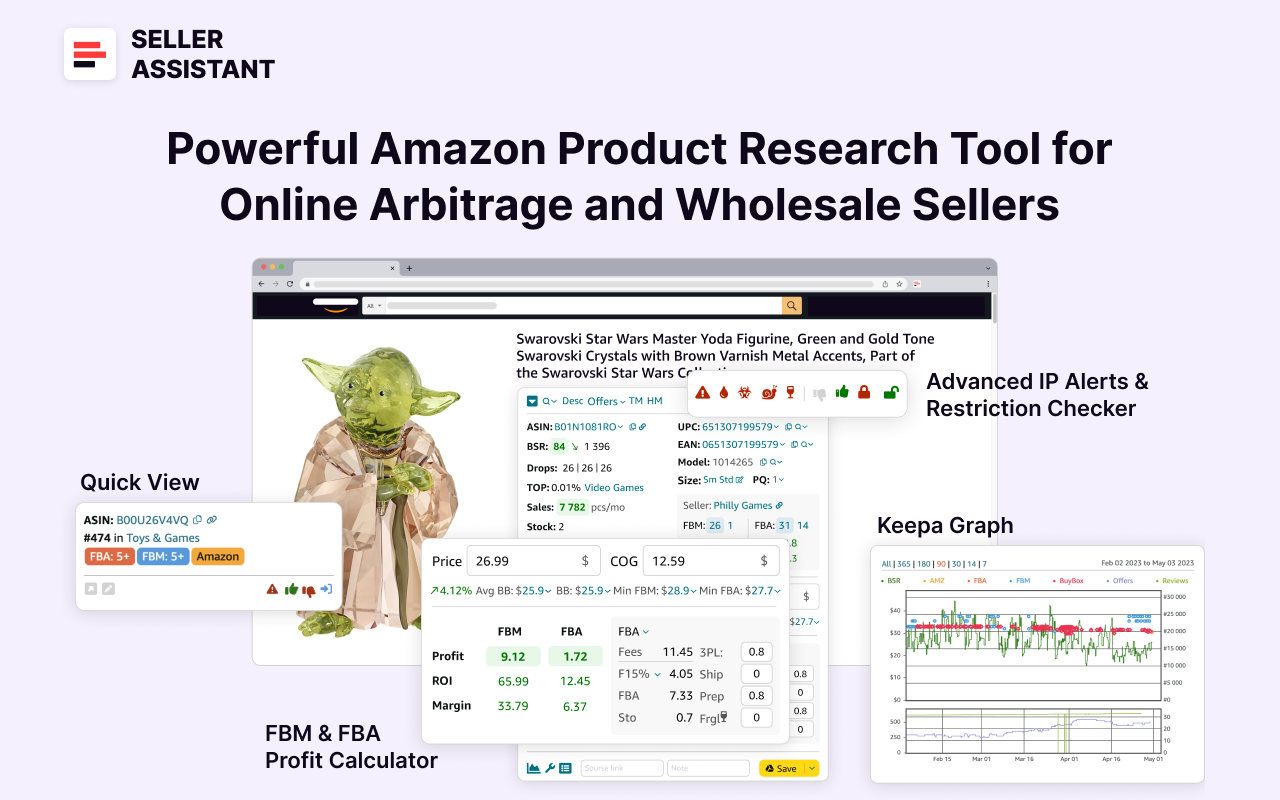
Seller Assistant’s Quick View feature appears on your Amazon search pages and shows the most essential product details.

This will let you understand at first glance the product category, how well the product sells (Best Sellers Rank, BSR), competition level (FBA and FBM offer count), if you can sell it on your Amazon account, and other key details. That way, you can see which products are worth researching and skip those you shouldn’t spend time on it.

Quick View data
- Product’s ASIN (Amazon Standard Identification Number); you can also click to copy the ASIN or the product link;
- Product’s BSR (Best Sellers rank) in its main category;
- The number of FBA and FBM sellers selling a product;
- Your eligibility to sell a product on your seller account;
- Product restrictions;
- Whether Amazon sells the product;
- You can also add notes to a product.
How to choose an online arbitrage product category?
Amazon groups similar products together into distinct groups (categories) and subgroups (subcategories). With this structure, shoppers can efficiently locate desired products, while sellers can sell their products within the relevant categories.
Since some categories and subcategories are more popular than others, look for the categories that are popular but not have too high competition. You can see the product category in the Quick View.
Choosing your category
.webp)
Avoid restricted categories
Amazon restricts selling in certain categories. These categories may require approval and additional documentation. New sellers may find it easier to avoid restricted categories initially.
Popularity vs. competition
While popular categories like Beauty and Personal Care or Clothing and Shoes might seem appealing, they're also highly competitive. The key is to find a balance. Consider categories with steady customer demand but manageable competition. Examples are Electronics, or Toys and Games.
Research subcategories
Investigate subcategories within the main categories you're considering. Subcategories can target more specific customer segments, potentially increasing your product's visibility to the targeted audience.
Leverage your expertise
Starting with a category you're familiar with can be a smart move. Your knowledge will translate into better product understanding and selection.
Top product categories

Related: Top Amazon Product Categories
Where to find online arbitrage product ideas on Amazon?
There are many places on Amazon where you can find top-selling product ideas. Below you can find the most popular of them. Quick View appears on your Amazon pages and collects the essential product details to help you make your choice.
Amazon Best Sellers
A good place to find new product ideas is Amazon Best Sellers. Amazon's Best Sellers list shows the most popular Amazon FBA products, so it's a great place to get ideas for very popular products. You can browse the list or filter by category to see what's trending and identify potential niches.
Amazon Movers & Shakers
Amazon Movers & Shakers shows the products that have seen the biggest sales increases over the last 24 hours, so it's an excellent way to find trending products.
However, you must check their BSR over time to make sure their demand is consistent. For that, you can use Seller Assistant. It shows the BSR over the last 30, 90, and 180 days.

“Customers who bought this item also bought” and “Products related to this item”
Amazon has a recommendation algorithm that shows products frequently bought together by shoppers. The “Customers who bought this item also bought” and “Products related to this item” sections appear when you scroll down the Amazon product listing page.
You can use these sections to find product ideas similar to popular products or brands, or those that customers are looking for.

Customer reviews
Reviews can be a great source of insights. Look for products with common customer complaints or suggestions for improvement. These could be opportunities to look for a product that addresses those issues.
Amazon Hot New Releases
Stay updated on the latest product launches and trending items updated hourly through the Hot New Releases section. Get an idea of how similar products are performing and capitalize on the products that cater to early adopters.

Amazon Most Wished For
Amazon Most Wished For section reveals products customers frequently add to Wishlists and registries. It can indicate high demand for specific products and potential opportunities, especially if there's a lack of competition in those areas.

How to Research Products for Online Arbitrage?
When you’ve chosen a product idea, you must research it, make sure it will sell and will bring the profit you expect.
To simplify this process, sellers use a product research checklist and make sure the product meets that checklist.
To research a product, we will use Seller Assistant, a popular and effective product-sourcing software. It allows you to choose items with good profit potential and no issues.
13 steps to researching Amazon products
Step 1. Remove the referral from the product link
Make sure the product link you use doesn’t contain a referral (part of the link, starting with ref=). It can give you wrong information about the product.
Method. Delete the part of the link, starting with ref= and refresh the page.

Step 2. Check a product for IP alerts
IP (intellectual property) complaints happen when brands complain to Amazon that other sellers resell that brand’s product without its permission. Amazon will not allow you to list such products because they are trademarked.
Method. You can detect products with IP complaints with Seller Assistan’s IP Alert feature. It shows the red triangle icon if a product has IP complaints and the type of IP complaint. That means you must stay away from that product and brand.
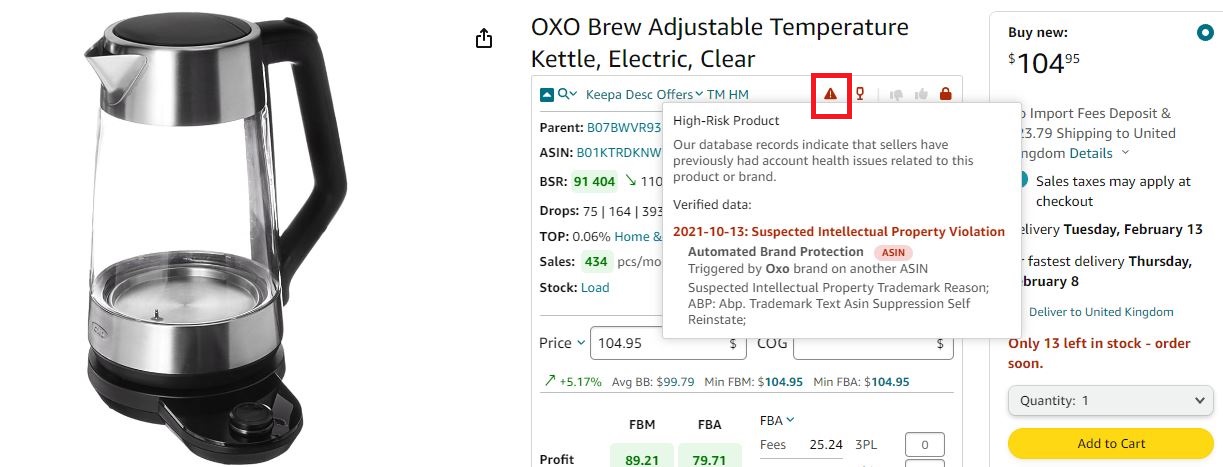
Step 3. Check competition by FBA seller count
The next step helps avoid products with high competition. If many sellers compete, they drop the price and you can lose much of the profit. The «good» count of FBA seller offers must range from 2 to 15.
Method. You can see the count of FBA sellers with Seller Assistant. It shows the count of FBA and FBM sellers on the product and search pages. The number on a blue background is the count of all FBA or FBM sellers. The number on the white background next to it is the count of FBA or FBM sellers offering the Buy Box price +5% (your potential competitors).

Related: How to Avoid a Price War on Amazon
Step 4. Check if Amazon is a seller
If Amazon sells a product, it is not suitable for selling. That is because it is almost impossible to compete with them.
Method. You can see if Amazon is a Buy Box seller with Seller Assistant. It shows the Red Amazon icon on the product and search pages.
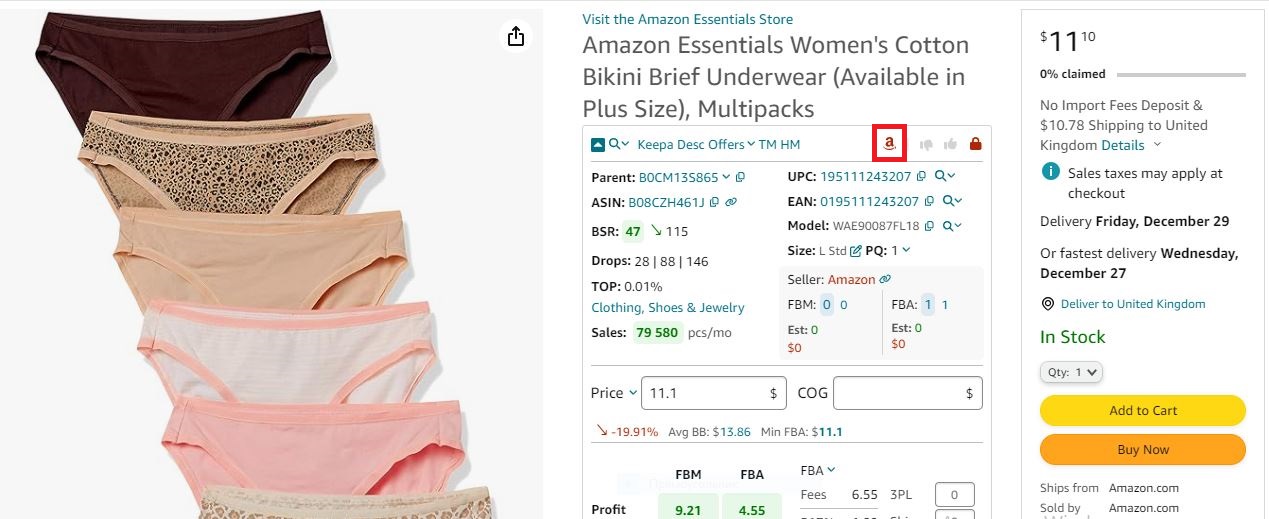
Step 5. Check out the listing age
The product listing must be old enough so that you can see how the product sales and price behaved over time. The «good» listing age is half a year or more.
Method. You can see that on the Keepa charts integrated within Seller Assistant. If a product is new, the chart will not show you any data before a certain period.

Step 6. Find out how well the product sells
Amazon has a special indicator called Best Sellers Rank (BSR) to estimate how good (or bad) the product sells, but it doesn’t give you the number of sales. It shows the sales trend. The lower the rank, the better the product sells. It constantly changes, so you must look at the average BSR over 90 days.
Method. Seller Assistant calculates how many products you can potentially sell per month in the Sales field. Drops (BSR drops) show how many products were sold during 30, 90, and 180 days.
You can also see BSR figures with Seller Assistant. If the BSR number is green and the arrow beside it points down, the product is a good option for selling. If the BSR number is red and the arrow beside it points up, the product is not a good option for selling.

Related: Amazon Best Sellers Rank – Everything You Need to Know
Step 7. Estimate the selling price
Look at the maximum and minimum price and average Buy Box price (now Amazon calls it Featured Offer price).
Method. Seller Assistant shows the average Buy Box price (Avg BB), and if it goes up or down compared to a 90-day price (green arrow up or red arrow down). It also shows the lowest FBA (Min FBA) and lowest FBM (Min FBM) prices. You can set your price somewhere in between. You can use this price level to calculate if your product will bring profit.

Related: What is Buy Box? How to Win Buy Box on Amazon
Step 8. Research if the product has variations
If a product has variations, not all of them will sell equally well. If you want to sell a product with variations, you must select one of the best-selling variations. However, the BSR doesn’t show which sells the best because it is calculated for the whole variation family (all variations together).
Method. Seller Assistant’s Variation Viewer lets you quickly see all variations' rating share, total ratings, and the rating percentage per variation (Share). The highest rating percentage indicates the most profitable variations. Variation Viewer also shows if a variation is out of stock.
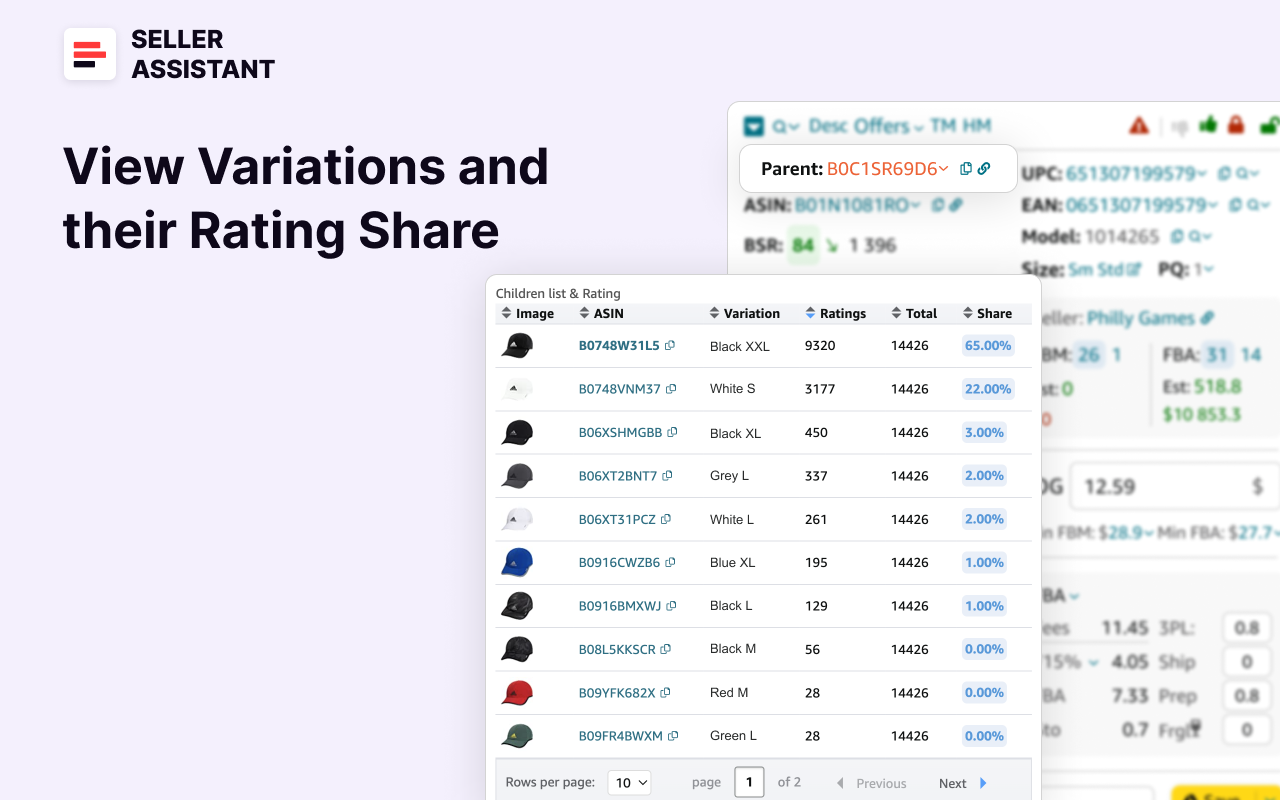
Related: How to Add a Variation to an Existing Amazon Listing — Сomplete Guide
Step 9. Look at product reviews
A «good» product must have reviews, and the rating must be above 4 stars. If it doesn’t, it has too recent sales history or doesn’t sell.
Method. Seller Assistant shows reviews on the separate Keepa chart. The average rating must be 4-5 stars, and it must not have many negative reviews.
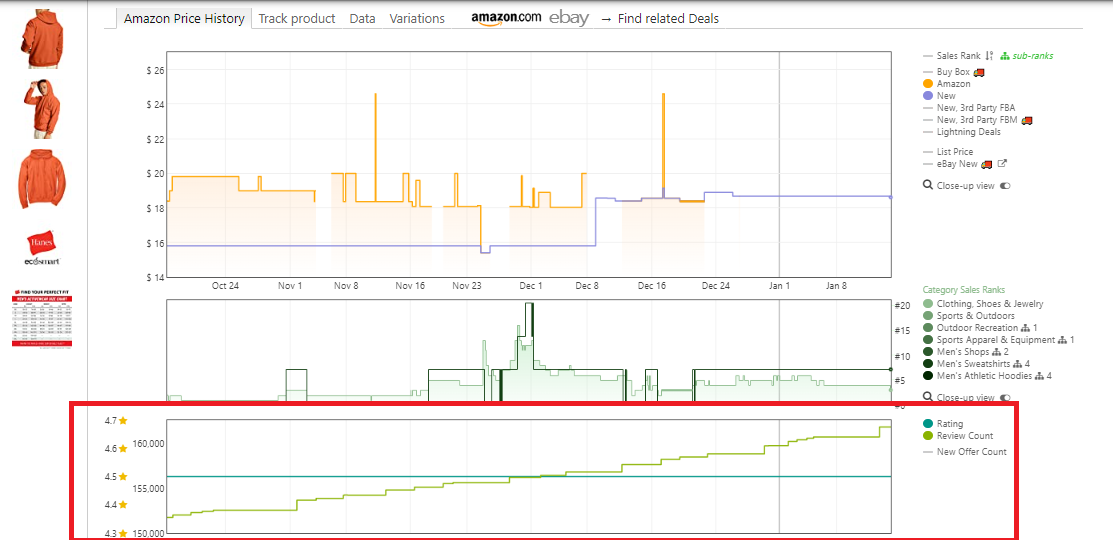
Step 10. Verify selling eligibility and restrictions
You may not be eligible to sell some products on your account. You must check that before buying products because Amazon may not allow you to add them to the listing.
Method. Seller Assistant shows a green open lock icon if you can sell a product and a red closed lock icon if you can’t.
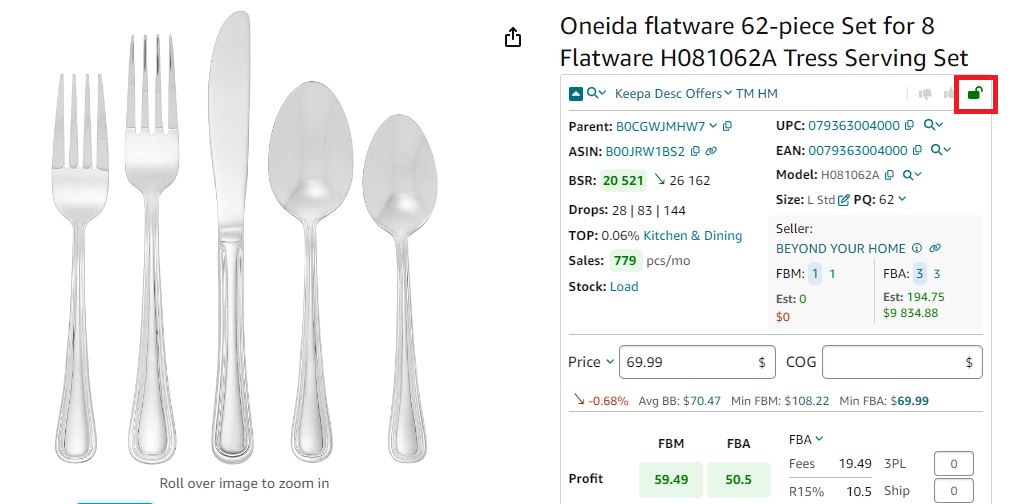
Step 11. Check product for flags
Product flags are alerts prompting that a product can create problems when you sell it on Amazon.
Examples are oversize, fragile, meltable, hazmat, adult, and other products. They either belong to restricted categories (hazmat, adult), require extra shipping costs (heavy and bulky, fragile), or don’t sell all year round (melable). That means it’s better to avoid such products.
Method. Seller Assistant shows all product alerts directly on the Amazon product and search pages.
Seller Assistant alerts
- Closed Red Lock icon — you can’t sell the product on your account, or it belongs to a restricted category;
- Red Triangle icon — IP alert;
- Red Box icon — a product is oversize;
- Red Glass — a product is fragile;
- Red Drop — a product is meltable;
- Hazmat icon — a product belongs to the hazardous materials;
- 18+ — a product belongs to Adult goods;
- Red Amazon icon — Amazon is a Buy Box seller;
- GB — generic brand (you can’t add your offer to the listing).

Related: Seller Assistant App: What Products to Avoid Selling on Amazon?
Step 12. Assess estimated sales
Estimated sales are how many product units you can sell per month. Your target estimated sales depend on how much you plan to make to cover expenses and make enough profit.
Method. Seller Assistant calculates estimated sales for each product if you become one more seller on the listing. The figure appears in the ‘Est’ line. This helps you understand if you can sell as many units as you expect.

Step 13. Calculate product profitability
ROI (Return on Investment) shows how profitable is your Amazon business. Typically, anything above 10% is considered a “good” ROI for your Amazon business. At this point, you will only need an estimated ROI to have an idea if a product is profitable (or not).
Method. To calculate ROI, you must know the Cost of Goods Sold (COG, the product price at the supplier). You can look up the price at several suppliers and take the average.
Seller Assistant’s Quick Links allow you to quickly search products on Google, Google Shopping, eBay, Walmart, Target, Webstaurant, Katom, The Home Depot, and Alibaba, and find the suppliers and prices. To do that, click on the search icon, and in the drop-down, select a website you want to search. You will be redirected to search results.
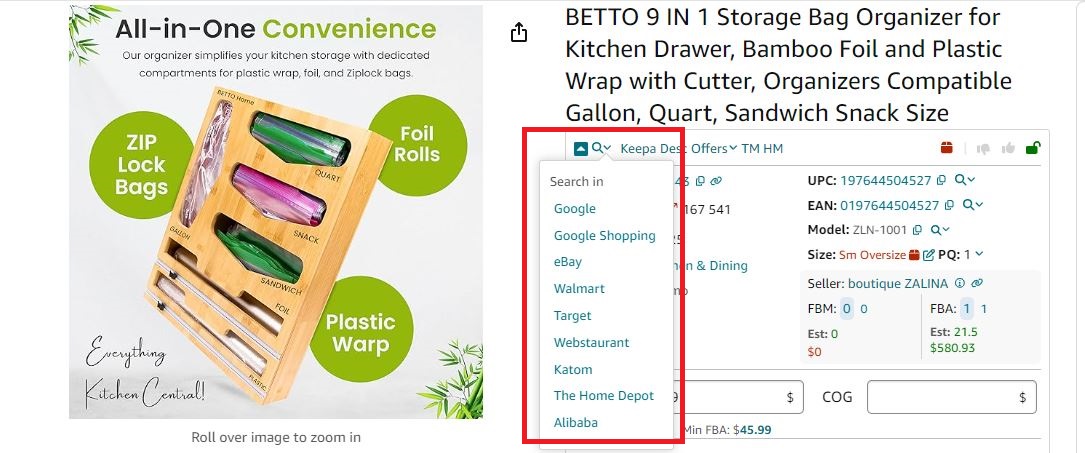
Then, you can quickly calculate ROI with Seller Assistant’s FBA&FBM profit calculator. It will be displayed on the Amazon product pages. Aim for Return on Investment (ROI) above 10% to ensure profitability.

How to Find Suppliers for Online Arbitrage Products?
When you researched a product and decided it meets all the criteria you want, you must look for a reliable supplier who offers low prices for your product.
Online arbitrage sellers typically use reverse sourcing to look for their suppliers. With this method, you select a product on Amazon and find its match at the supplier. That means you find a suitable product on Amazon and look for the same product at a much lower price at the supplier.

To simplify supplier search, we will use Seller Assistant,
6 Steps to find a supplier for Amazon online arbitrage product
Step 1. Open on Amazon a product you want to sell.
Step 2. Explore supplier options
Open Seller Assistant and click the search icon in the top left corner. Seller Assistant will display a drop-down list with the most popular supplier websites.
Seller Assistant supplier links
- Google Shopping;
- eBay;
- Walmart;
- Target;
- Webstaurant (Home and Kitchen supplies);
- Katom;
- The Home Depot;
- Alibaba (for international sourcing).

Step 3. Redirect to search results
Select a supplier website from the list and Seller Assistant will then redirect you to the search results page for that product on the chosen supplier's platform.
Step 4. Make sure your product on Amazon matches the one at the supplier
Open the product with the best price. Activate the Seller Assistant’s Side Panel View icon. It will automatically appear on the supplier's website.
Compare all product information on Amazon and at the supplier: brand name, model, size, color, materials, and pictures to check if they are identical.

Step 5. Calculate profit and ROI with Seller Assistant’s FBA&FBM profit calculator
Enter the Cost of Goods (product price at the supplier), choose the fulfillment method, add prep center or 3PL costs if you use these services, get the profit and ROI figures, and see if they meet our criteria.

Step 6. Verify the supplier (optional)
If a product at the supplier looks fine, it’s time to order. However, if you use an unknown supplier, you must verify if they’re legitimate. Check on LinkedIn or online business directories like Whois or ScamAdviser.
Supplier verification methods
- Research if they have an advanced website;
- Check contact and payment details;
- Verify if they have active social media;
- Look into Google references.
Step 7. Order a product from the supplier.
What If I Want to Buy Ready-to-Sell Online Arbitrage Deals?
If you consider buying online arbitrage leads, there is a prefect solution. You can buy single leads on the Seller Assistant Deals marketplace.

Seller Assistant Deals is a marketplace where online arbitrage buyers and sellers trade leads. It offers verified fast-selling and profitable leads from professional Amazon product researchers.
Seller Assistant Deals advantages
You can buy individual leads and select the ones you want;

Targeted selection
Unlike typical leads lists, Seller Assistant Deals allows you to buy individual leads, giving you complete control over the products you choose to sell. You can focus on items that align with your business strategy and expertise.
Verified deals
With Seller Assistant Deals, you can forget about unreliable or expired leads. It offers deals verified by professional moderators. The deals have guaranteed profitability, match supplier products, and are in stock.
Guaranteed eligibility
Seller Assistant Deals checks if you can sell the selected products from your seller account.
Limited offer
All leads are limited offers. Each lead is sold to up to 3 buyers in within each 30 day periods.
Refund guarantee
Seller Assistant Deals provides a safety net with a refund warranty. If a product on the supplier's website differs from what is described or is out of stock, you get your money back.
FAQ
How to find high-selling Amazon products?
To find high-selling Amazon products, use Seller Assistant. This product sourcing software calculates how many products you can potentially sell per month and shows BSR drops which indicate how many products were sold during 30, 90, and 180 days. It also calculates estimated sales for each product if you become one more seller on the listing.
How do I choose the best product to sell on Amazon?
You can choose Amazon online arbitrage items to sell with product sourcing. It includes three parts: finding a popular product that will sell well, researching it, and choosing a supplier that offers a low price. Use product sourcing software like Seller Assistant to make the best choice.
What is the most lucrative thing to sell on Amazon?
There's no single "most lucrative" product on Amazon. Success depends on finding a balance between high demand, manageable competition, and high profit and ROI. Use product sourcing software like Seller Assistant to find such products.
What is the most sold item?
The most sold category is clothing, including everything from women's dresses to children's shoes. However, the category most popular among Amazon sellers in 2024 is Home and Kitchen.
Final Thoughts
As an Amazon online arbitrage seller, finding profitable products to sell is your key target. To do that quickly and effectively, sellers use product sourcing tools.
Seller Assistant is the best tool to find profitable products for Amazon online arbitrage. This unique set of browser extensions, tools, and features combines two extensions: Seller Assistant Browser Extension, and IP-Alert Chrome Extension by Seller Assistant, product sourcing tools: Bulk Restrictions Checker and UPC/EAN to ASIN converter, and features: Side Panel View, FBM&FBA Profit Calculator, Quick View, ASIN Grabber, Stock Checker, IP Alert, and Restrictions Checker.

.svg)














